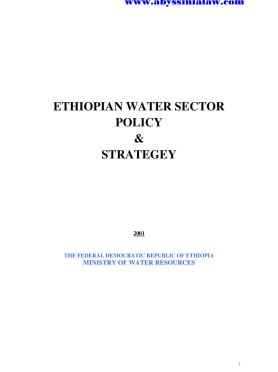Water Policy (English)
Water Policy (English)
The geographical location of Ethiopia and its endowment with favorable climate provides a relatively higher amount of rainfall in the region. Much of the water, however, flows across the borders being carried away by the transboundary rivers to the neighboring countries. Although we can not be definite due to lack of researched data as yet, preliminary studies and professional estimates indicate that the country has an annual surface runoff of close to 122 billion cubic meters of water excluding ground water.
The big and main water resources problem in Ethiopia is the uneven spatial and temporal occurrence and distribution. Between 80-90% of Ethiopia's water resources is found in the four river basins namely, Abay (Blue Nile), Tekeze, Baro Akobo, and Omo Gibe in the west and south-western part of Ethiopia where the population is no more than 30 to 40 per cent. On the other hand, the water resources available in the east and central river basins is only 10 to 20 per cent whereas the population in these basins is over 60 per cent.
The figures indicated above attempt to show the spatial uneven water distribution. The temporal distribution poses no lesser trouble. Ethiopia gets plenty of annual rainfall on the aggregate. It falls either ahead of time or comes too late or even stops short in mid-season. The required amount is not available at the right time.
In order to alleviate the problems on agricultural outputs and other water users, sustainable and reliable development and proper use of the water resources of Ethiopia becomes an imperative. Obviously this calls for a priority setting and judicious water resources management policy and associated finance. Development activities carried out so far in the water sector in totality or individually reveal a very low level of performance. The cause for this poor achievement and the dillema for the failure of the country's water resources to significantly contribute to the overall socio-economic development of the Ethiopian peoples lies mainly in the absence of a well defined coherent policy and the lack of the required huge investment.

